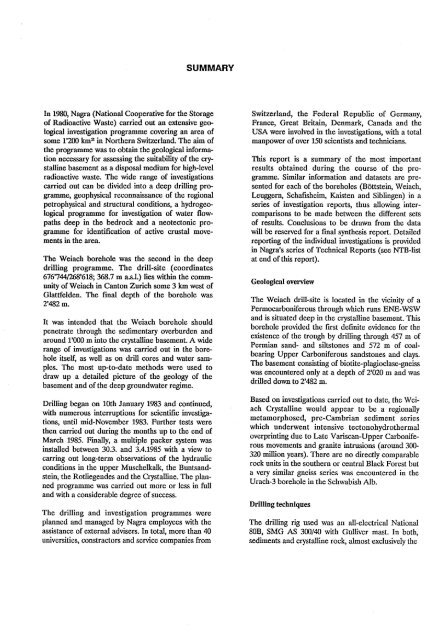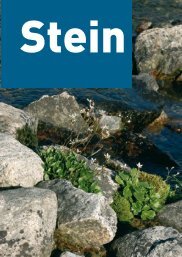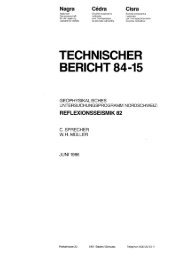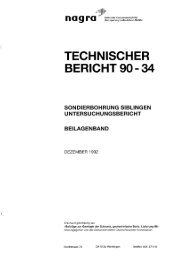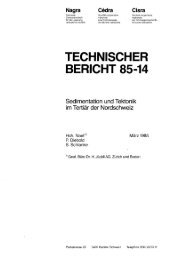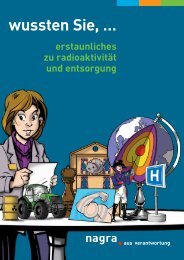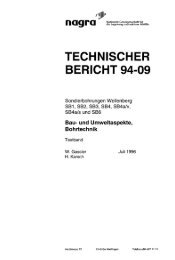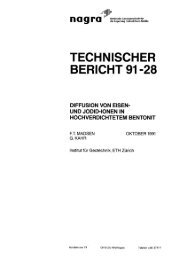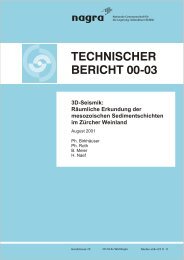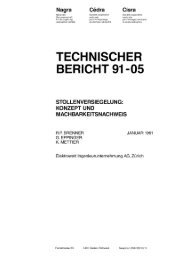Deutsch (27.2 MB) - Nagra
Deutsch (27.2 MB) - Nagra
Deutsch (27.2 MB) - Nagra
Sie wollen auch ein ePaper? Erhöhen Sie die Reichweite Ihrer Titel.
YUMPU macht aus Druck-PDFs automatisch weboptimierte ePaper, die Google liebt.
SUMMARY<br />
In 1980, <strong>Nagra</strong> (National Cooperative for the Storage<br />
of Radioactive Waste) carried out an extensive geological<br />
investigation programme covering an area of<br />
some 1'200 km 2 in Northern Switzerland. The aim of<br />
the programme was to obtain the geological information<br />
necessary for assessing the suitability of the crystalline<br />
basement as a disposal medium for high-level<br />
radioactive waste. The wide range of investigations<br />
carried out can be divided into a deep drilling programme,<br />
geophysical reconnaissance of the regional<br />
petrophysical and structural conditions, a hydrogeological<br />
programme for investigation of water flowpaths<br />
deep in the bedrock and a neotectonic programme<br />
for identification of active crustal movements<br />
in the area.<br />
The Weiach borehole was the second in the deep<br />
drilling programme. The drill-site (coordinates<br />
676'744/268'618; 368.7 m a.s.l.) lies within the community<br />
of Weiach in Canton Zurich some 3 km west of<br />
Glattfelden. The [mal depth of the borehole was<br />
2'482m.<br />
It was intended that the Weiach bore hole should<br />
penetrate through the sedimentary overburden and<br />
around 1'000 m into the crystalline basement. A wide<br />
range of investigations was carried out in the borehole<br />
itself, as well as on drill cores and water samples.<br />
The most up-to-date methods were used to<br />
draw up a detailed picture of the geology of the<br />
basement and of the deep groundwater regime.<br />
Drilling began on 10th January 1983 and continued,<br />
with numerous interruptions for scientific investigations,<br />
until mid-November 1983. Further tests were<br />
then carried out during the months up to the end of<br />
March 1985. Finally, a multiple packer system was<br />
installed between 30.3. and 3.4.1985 with a view to<br />
earring out long-term observations of the hydraulic<br />
conditions in the upper Muschelkalk, the Buntsandstein,<br />
the Rotliegendes and the Crystalline. The planned<br />
programme was carried out more or less in full<br />
and with a considerable degree of success.<br />
The drilling and investigation programmes were<br />
planned and managed by <strong>Nagra</strong> employees with the<br />
assistance of external advisers. In total, more than 40<br />
universities, constractors and service companies from<br />
Switzerland, the Federal Republic of Germany,<br />
France, Great Britain, Denmark, Canada and the<br />
USA were involved in the investigations, with a total<br />
manpower of over 150 scientists and technicians.<br />
This report is a summary of the most important<br />
results obtained during the course of the programme.<br />
Similar information and datasets are presented<br />
for each of the boreholes (Bottstein, Weiach,<br />
Leuggern, Schafisheim, Kaisten and Siblingen) in a<br />
series of investigation reports, thus allowing intercomparisons<br />
to be made between the different sets<br />
of results. Conclusions to be drawn from the data<br />
will be reserved for a [mal synthesis report. Detailed<br />
reporting of the individual investigations is provided<br />
in <strong>Nagra</strong>'s series of Technical Reports (see NTB-list<br />
at end of this report).<br />
Geological overview<br />
The Weiach drill-site is located in the vicinity of a<br />
Permocarboniferous through which runs ENE-WSW<br />
and is situated deep in the crystalline basement. This<br />
borehole provided the fIrst defmite evidence for the<br />
existence of the trough by drilling through 457 m of<br />
Permian sand- and siltstones and 572 m of coalbearing<br />
Upper Carboniferous sandstones and clays.<br />
The basement consisting of biotite-plagioclase-gneiss<br />
was encountered only at a depth of 2'020 m and was<br />
drilled down to 2'482 m.<br />
Based on investigations carried out to date, the Weiach<br />
Crystalline would appear to be a regionally<br />
metamorphosed, pre-Cambrian sediment series<br />
which underwent intensive tectonohydrothermal<br />
overprinting due to Late Variscan-Upper Carboniferous<br />
movements and granite intrusions (around 300-<br />
320 million years). There are no directly comparable<br />
rock units in the southern or central Black Forest but<br />
a very similar gneiss series was encountered in the<br />
Urach-3 borehole in the Schwabish Alb.<br />
Drilling techniques<br />
The drilling rig used was an all-electrical National<br />
80B, SMG AS 300/40 with Gulliver mast. In both,<br />
sediments and crystalline rock, almost exclusively the


